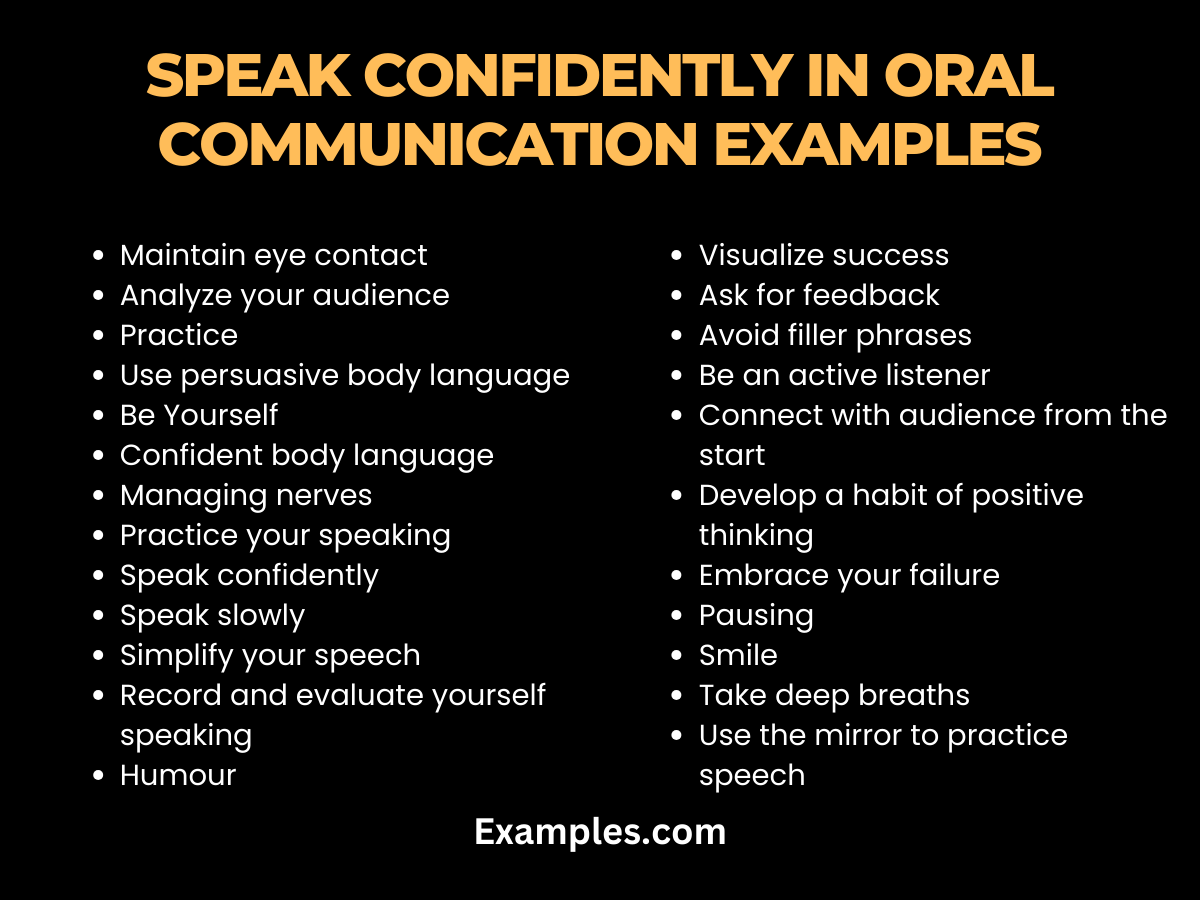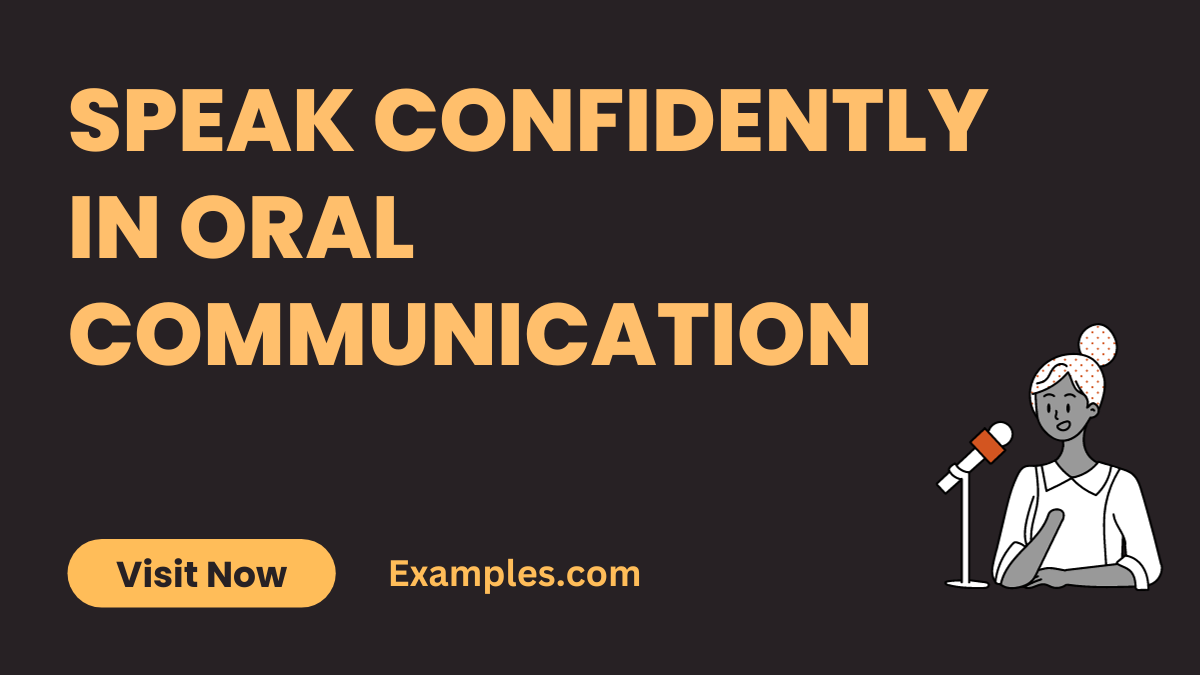Speak Confidently in Oral Communication
Mastering the skill of Speak confidently in Oral Communication is essential for effective interpersonal interactions. Whether it’s for a business presentation, academic discussion, or casual conversation, the ability to communicate your ideas clearly and confidently can significantly impact your success. This comprehensive guide delves into various strategies and techniques to enhance your speaking prowess. We provide practical tips and a wide array of Communication Examples, enabling you to navigate through different conversational landscapes with ease. By the end of this guide, you’ll be equipped with the tools to articulate your thoughts confidently and leave a lasting impression in any communication setting.
What is Confidence in Oral Communication?

Confidence in oral communication refers to the self-assurance a person exudes while speaking. It’s not just about what is said, but how it’s said. Confident communicators convey their message clearly and assertively, maintaining steady eye contact and an open posture. They speak at a comfortable pace, using a tone that is both engaging and authoritative. This confidence helps in persuading and influencing the audience, making interactions more effective and memorable.
30 Speak Confidently in Oral Communication Examples

Confidence is key in Oral Communication. It’s about delivering your message clearly and assertively, using body language effectively, and engaging with your audience. To Speak confidently in Oral Communication, focus on clarity, maintain eye contact, and use a steady, assertive tone. This guide offers 30 unique examples to help you communicate confidently across various scenarios.
Maintain Eye Contact
Maintaining eye contact is crucial in establishing trust and connection with your audience. It shows confidence and helps in engaging listeners.
Example: During a presentation, periodically make eye contact with different audience members to create a sense of inclusivity.
Analyze Your Audience
Understanding your audience’s interests and expectations allows you to tailor your speech effectively.
Example: Before speaking at a seminar, research the attendees’ backgrounds to align your content with their interests.
Practice
Regular practice enhances your fluency and confidence in delivering speeches.
Example: Rehearse your speech multiple times before the actual presentation to refine your delivery.
Use Persuasive Body Language
Effective body language, such as open gestures, can make your speech more convincing.
Example: Use hand gestures to emphasize key points in your argument.
Be Yourself
Authenticity in speech creates a genuine connection with the audience.
Example: Share personal stories or experiences relevant to your topic to establish a real connection.
Confident Body Language

Displaying confident body language, like standing tall, projects assurance.
Example: Stand upright with open shoulders while addressing a group to show confidence.
Managing Nerves
Managing anxiety is key to a smooth delivery. Techniques like deep breathing can help.
Example: Take deep breaths before starting your speech to calm your nerves.
Practice Your Speaking
Continuous speaking practice helps in refining your articulation and pacing.
Example: Practice speaking in front of friends or a mentor for constructive feedback.
Speak Confidently

Speaking with confidence involves a steady voice and assured posture.
Example: Use a firm, clear voice when making key points to exhibit confidence.
Speak Slowly
Speaking slowly and clearly aids in better comprehension by the audience.
Example: Deliberately pace your speech to allow the audience to absorb the information.
Visualize Success
Positive visualization can boost confidence and reduce speaking anxiety.
Example: Imagine a successful speech outcome to foster a positive mindset.
Ask for Feedback
Constructive feedback is invaluable for improving your speaking skills.
Example: After a speech, ask colleagues for input on areas of improvement.
Avoid Filler Phrases
Eliminating fillers like “um” and “uh” makes your speech more professional.
Example: Pause briefly instead of using filler words to collect your thoughts.
Be an Active Listener
Active listening during discussions shows respect and engagement.
Example: Nod and provide verbal affirmations when others speak to show attentiveness.
Connect with Audience from the Start
Engaging the audience from the beginning sets the tone for effective communication.
Example: Start with a relatable anecdote to draw the audience’s interest.
Develop a Habit of Positive Thinking
A positive mindset enhances confidence and reduces speech anxiety.
Example: Replace negative thoughts about speaking with positive affirmations.
Embrace Your Failure
Learning from speaking failures leads to improvement.
Example: Reflect on past speaking challenges to identify areas for growth.
Humour
Appropriately timed humour can make your speech more engaging.
Example: Incorporate light-hearted jokes related to your topic.
Pausing
Pausing at key moments adds emphasis and aids in audience comprehension.
Example: Pause after making a significant point to let it resonate with the audience.
Record and Evaluate Yourself Speaking
Recording and reviewing your speeches helps identify areas for improvement.
Example: Record a practice session and critique your delivery and body language.
Simplify Your Speech
Using simple language makes your message more accessible.
Example: Choose straightforward words over complex jargon for clarity.
Smile
Smiling can make you appear more approachable and confident.
Example: Smile during greetings and lighter moments of your speech.
Take Deep Breaths
Deep breathing helps in managing anxiety and maintaining vocal control.
Example: Take a few deep breaths before starting to stabilize your voice.
Use the Mirror to Practice Speech
Practicing in front of a mirror allows you to observe and adjust your body language.
Example: Rehearse your speech in front of a mirror to monitor facial expressions and gestures.
How to Speak with Confidence in Public
- Prepare Thoroughly: Research your topic to build a strong foundation. Example: For a product launch, understand every feature in detail.
- Practice Regularly: Rehearse your speech to improve fluency. Example: Practice in front of a mirror or record yourself to critique.
- Understand Your Audience: Tailor your message to their interests. Example: Use industry-specific examples for a professional audience.
- Use Positive Visualization: Imagine a successful speaking scenario. Example: Visualize the audience applauding to boost confidence.
- Control Breathing: Use deep breaths to manage anxiety. Example: Practice breathing exercises before going onstage.
- Adopt Confident Body Language: Stand tall and use open gestures. Example: Use hand movements to emphasize points.
- Engage with the Audience: Make eye contact and interact. Example: Ask rhetorical questions to involve listeners.
- Use Notes Wisely: Refer to notes for key points without over-relying. Example: Use bullet points on cards as prompts.
- Handle Mistakes Gracefully: Keep calm if you misspeak. Example: Pause, correct yourself, and continue smoothly.
- Seek Constructive Feedback: After your speech, ask for input. Example: Request specific suggestions for improvement.
How Do You Speak Confidently in Oral Communication?
- Clear Articulation: Speak clearly to ensure understanding. Example: Practice pronouncing difficult words in your speech.
- Appropriate Volume: Use a volume that suits the room size. Example: Increase volume for larger rooms.
- Steady Pace: Speak neither too fast nor too slow. Example: Time your speech to ensure proper pacing.
- Use Pauses Effectively: Pause for emphasis and comprehension. Example: Pause after making a key point.
- Confident Tone: Use a steady, assertive voice. Example: Practice speaking with a tone that conveys certainty.
- Positive Language: Use words that convey positivity. Example: Choose words that build up rather than tear down.
- Engaging Storytelling: Share relevant stories to connect. Example: Begin with a personal anecdote related to your topic.
- Answer Questions Confidently: Address audience queries with assurance. Example: Prepare answers for anticipated questions.
- Avoid Fillers: Eliminate “uhms” and “ahs” from speech. Example: Pause briefly instead of using fillers.
- Continual Improvement: Always look for ways to improve. Example: Watch videos of skilled speakers for inspiration.
Why is it Important to Speak Confidently in Oral Communication?
- Builds Credibility: Confidence enhances your authority. Example: Confidently discussing a topic can establish you as an expert.
- Engages Audience: Keeps listeners interested. Example: A confident tone can make even complex topics engaging.
- Facilitates Clarity of Message: Ensures your message is understood. Example: Confidently explaining a concept can aid comprehension.
- Promotes Trust: People trust confident speakers. Example: Confidently addressing concerns can build trust with stakeholders.
- Influences Decisions: Confidence can persuade others. Example: A confident pitch can sway investors’ decisions.
- Reduces Misunderstandings: Clear, confident communication minimizes errors. Example: Confidently giving instructions can reduce workplace misunderstandings.
- Enhances Professional Image: Boosts your professional reputation. Example: Confidently leading a meeting can enhance your workplace standing.
- Improves Networking: Confidence attracts professional connections. Example: Confidently interacting at conferences can expand your network.
- Facilitates Leadership: Leaders need to communicate confidently. Example: Confidently directing a team can improve leadership effectiveness.
- Encourages Feedback: Confidence invites open dialogue. Example: Confidently asking for feedback can yield more honest responses.
What are the steps to speaking confidently in Oral Communication
- Understand Your Topic: Deep knowledge of your subject ensures confidence. Example: Research thoroughly before a presentation to speak with authority.
- Practice Regularly: Practice leads to fluency and confidence. Example: Rehearse your speech multiple times to gain comfort with the material.
- Record and Review: Record your practice sessions to identify areas for improvement. Example: Watch your recordings to refine your speech and body language.
- Seek Feedback: Constructive criticism is valuable for growth. Example: Present to a trusted colleague and ask for honest feedback.
- Visualize Success: Imagine a positive outcome to boost confidence. Example: Picture yourself receiving applause after a successful presentation.
- Relaxation Techniques: Use techniques like deep breathing to calm nerves. Example: Perform breathing exercises before speaking to reduce anxiety.
- Work on Body Language: Adopt confident postures and gestures. Example: Stand tall and use hand gestures for emphasis while speaking.
- Engage with Audience: Make eye contact and interact with listeners. Example: Look at different audience members to create a connection.
- Use Notes Wisely: Notes can be a safety net but shouldn’t be a crutch. Example: Use bullet points instead of full sentences to avoid reading verbatim.
- Embrace Mistakes: Learn to accept and recover from errors gracefully. Example: If you misspeak, calmly correct yourself and move on.
Tips to Speak Confidently in Oral Communication
- Simplify Your Message: Convey your points clearly and concisely. Example: Use simple language and avoid jargon to ensure understanding.
- Use Stories and Analogies: They make your speech more relatable. Example: Share a personal story that illustrates your main point.
- Modulate Your Voice: Use varying tones to maintain interest. Example: Lower your tone for emphasis and raise it to express excitement.
- Pause for Effect: Strategic pauses add emphasis and aid comprehension. Example: Pause after a key point to let it sink in.
- Avoid Filler Words: They can undermine your confidence. Example: Replace “um” and “uh” with silent pauses.
- Maintain Positive Body Language: Open gestures indicate confidence. Example: Avoid crossed arms and instead gesture naturally.
- Prepare for Questions: Anticipate audience inquiries. Example: Think of potential questions and prepare your answers in advance.
- Use Humor Appropriately: It can ease tension and engage listeners. Example: Insert a relevant joke to lighten the mood.
- Believe in Yourself: Self-confidence is key to effective speaking. Example: Affirm your abilities before stepping onto the stage.
- Adapt to Audience Feedback: Be observant and adjust accordingly. Example: If the audience seems disengaged, change your approach or ask interactive questions.
Speaking confidently in Oral Communication is a skill that combines thorough preparation, practice, and self-awareness. By understanding your material, engaging with your audience, and using effective body language, you can significantly enhance your speaking abilities. This guide provides practical tips and examples to help you develop and refine these skills, empowering you to communicate more effectively and confidently in any setting.
To effectively conclude the article on Speak Confidently in Oral Communication, you can emphasize the transformative impact of confidence in communication. Highlighting how confidence not only enhances the speaker’s credibility but also engages and influences the audience, making the communication more effective and memorable. To extend the learning journey for readers, consider linking to Psychology Today’s article on “6 Ways to Speak with Greater Confidence” at Psychology Today. This resource provides additional insights and practical tips on building speaking confidence, even for anxious speakers??.
Additionally, integrating a link to SkillsYouNeed’s page on “Questioning Skills and Techniques” at SkillsYouNeed can offer readers valuable information on effective questioning, a key component of confident oral communication. This page discusses various purposes of questions in communication, such as obtaining information, maintaining control of the conversation, expressing interest in others, and encouraging deeper thought????.
These external links, from high-authority and educational websites, not only enrich the article with diverse perspectives but also provide readers with practical tools and strategies to enhance their oral communication skills, particularly in speaking confidently.



